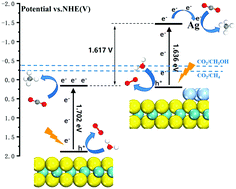DFT study on Ag loaded 2H-MoS2 for understanding the mechanism of improved photocatalytic reduction of CO2†
Abstract
Transition metal modified molybdenum disulfide to improve the performance of photocatalytic reduction of carbon dioxide has been receiving much attention. Herein, a novel high-efficiency photocatalytic composite Ag/2H-MoS2 has been constructed and simulated using density functional theory (DFT) for unveiling the mechanism of improved photocatalytic reduction of CO2 in our experimental research. Our calculations about the band structure and electronic and optical properties indicate that the loading of Ag atoms enhances the photocatalytic performance of 2H-MoS2 nanosheets by transferring the photogenerated electrons from the valence band of 2H-MoS2 to the loaded Ag atoms. Furthermore, 20 wt% Ag loaded 2H-MoS2 is the most suitable for the thermodynamic requirement of reducing CO2 to CH4 among the catalysts with different Ag loadings, and the formation of *CHO in 20 wt% Ag/2H-MoS2 is the potential-determining step, whose Gibbs free energy reduces from 2.830 eV of 2H-MoS2 to 0.925 eV. Meanwhile the thermochemical results predict the best path for reducing CO2 on such a photocatalyst as CO2 → *COOH → *CO → *CHO → *CH2O → *OCH3 → *CH3OH → CH4. The photocatalytic performance of pristine 2H-MoS2 in CO2 reduction is therefore significantly improved by loading silver. This research provides a theoretical reference for transition metal modified 2H-MoS2 nanosheets.



 Please wait while we load your content...
Please wait while we load your content...